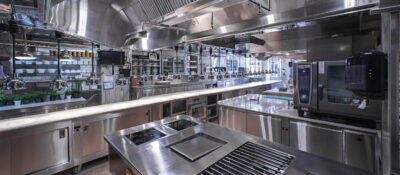In the fast-paced world of restaurant businesses, architects are taking center stage in driving innovation. Architects Are Revolutionising Commercial Kitchen Designs their vision and creativity are transforming commercial kitchens, creating spaces that not only enhance the culinary experience but also optimize efficiency.By embracing futuristic commercial kitchen designs and engaging the expertise of skilled architects, restaurants can thrive in an ever-competitive industry. Innovations in technology and sustainability will not only enhance customer experiences but also streamline operations, leading to higher profits and a brighter future for the foodservice industry.
1.The Evolution of Commercial Kitchens
Over time, commercial kitchens have evolved from basic functional spaces to sophisticated hubs of technology and design. Architects have adapted their approach to meet changing needs, focusing on maximizing workflow and minimizing wasted space.
2.Embracing Futuristic Design Concepts
Futuristic commercial kitchens reimagine the traditional layout, incorporating elements like modular setups, smart storage solutions, and state-of-the-art equipment. The integration of technology allows seamless coordination between kitchen staff, improving overall productivity.
3.Top Innovations for Modern Restaurants
Architects are introducing cutting-edge innovations, such as automated cooking processes, robotic assistants, and augmented reality displays. These advancements streamline operations, reduce human error, and captivate customers with immersive dining experiences.
4. Integrating Technology for Efficiency
From automated inventory management to AI-powered cooking, architects leverage technology to make commercial kitchens more efficient. By optimizing energy usage and reducing waste, restaurants can enhance their sustainability efforts while cutting costs.
5.Sustainability and Green Initiatives
Forward-thinking architects prioritize eco-friendly designs, incorporating sustainable materials and energy-efficient systems. Green kitchens not only reduce the environmental impact but also resonate with environmentally conscious consumers.
6. Ensuring Safety and Compliance
Architects pay meticulous attention to safety regulations and health codes, designing kitchens that meet industry standards. Fire safety measures, proper ventilation, and ergonomic layouts are among the crucial aspects architects consider to ensure a safe working environment.

FAQs
Q: Why is an industrial ventilation hood necessary for a commercial kitchen?
A: An industrial ventilation hood is essential for a commercial kitchen because it effectively removes smoke, steam, and cooking odors. This helps maintain a comfortable and safe working environment for kitchen staff and keeps the space clean and hygienic.
Q: What are the benefits of using stainless steel prep tables in a commercial kitchen?
A: Stainless steel prep tables are highly durable, resistant to stains, and easy to clean, making them ideal for the demanding conditions of a commercial kitchen. They also add a sleek and professional look to the kitchen, enhancing its overall design.
Q: Are glass door refrigeration units suitable for commercial kitchens?
A: Yes, glass door refrigeration units are suitable for commercial kitchens as they offer visibility and easy access to ingredients, which can improve efficiency during food preparation. Additionally, they add a modern and stylish touch to the kitchen’s design.
Conclusion
Incorporating the right commercial kitchen equipment into your establishment’s architectural design is essential for creating a functional and visually appealing culinary space. From commercial ranges and refrigeration units to industrial ventilation hoods and stainless steel prep tables, each piece plays a crucial role in enhancing your kitchen’s efficiency and aesthetics.







